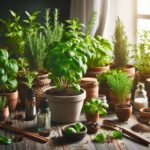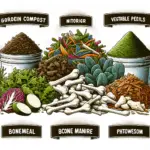1. Introduction
Organic gardening has gained immense popularity in recent years due to its numerous health and environmental benefits. Growing your own organic vegetables not only ensures that your food is free of harmful chemicals, but also helps reduce your carbon footprint and promotes sustainable living.
However, understanding the growing season in Texas is crucial for achieving a thriving garden. The state’s diverse climate and growing zones can make planting a bit of a challenge without the right knowledge.
Texas gardening presents unique opportunities and challenges due to the state’s varying temperatures, soil types, and growing conditions. For example, north Texas has a different planting schedule compared to areas in southern or central Texas, so it’s important to use region-specific guides like the north Texas planting guide or the Texas zone 8 planting schedule to get the best results. Being aware of the specific organic vegetable gardening season for zone 9a Texas can also be the key to growing healthy crops.
The primary objective of this article is to help readers successfully plan their organic garden throughout the year by understanding the planting season in Texas. Whether you’re wondering what to plant in May in Texas, which spring vegetables to plant, or when to start planting for fall, this guide will provide a comprehensive overview. We’ll also touch on specific topics such as the best Texas vegetable garden layout, when to plant vegetables in Texas, and strategies for successful organic gardening in different seasons.
By the end of this post, you’ll be equipped with all the essential knowledge to grow your own organic vegetables and take advantage of each planting season in Texas, allowing you to enjoy fresh, homegrown produce throughout the year.
2. Understanding Texas’ Climate Zones
Understanding the growing season in Texas begins with recognizing the state’s diverse climate zones. Texas is unique in that it spans multiple gardening regions, each with its own climate characteristics and challenges. These variations can significantly impact the timing and success of your organic gardening efforts.
2.1. Different Gardening Regions in Texas
Texas can be divided into several distinct gardening regions, including North, South, Central, and Coastal Texas. Each region presents different conditions that influence planting schedules and the types of crops that grow best. For example, the north Texas planting guide focuses on a cooler climate compared to the warmer and more humid conditions found in Coastal Texas. In zone 8, which includes much of Central Texas, the Texas zone 8 planting schedule can help guide you on when to start planting specific vegetables throughout the year.
2.2. Effects of Climate on Organic Gardening
The effects of climate on organic gardening in Texas cannot be overstated. Temperature and humidity play a huge role in determining which vegetables will thrive in each season. For example, during the hot summer months, it’s important to consider how heat and water availability will impact plant growth. Understanding these elements can help you plan the organic vegetable gardening season in zone 9a Texas more effectively, ensuring your plants have the best possible environment to thrive. The organic gardening season Texas residents experience can vary widely, and adjusting your garden to adapt to these conditions is key.
2.3. Microclimates in Texas
In addition to understanding the broader climate zones, gardeners should also take microclimates into account. A microclimate is a smaller area within your garden that may have slightly different conditions compared to the rest. Factors like shade, wind exposure, and soil composition can create microclimates, making them ideal for certain vegetables. Identifying these microclimates within your own garden can help you determine the best locations for different crops, optimizing the growing season in Texas. This is especially important for organic gardening, where precise placement can help avoid pests and diseases without the use of chemicals.
With this understanding of Texas’ climate zones, you’ll be well-equipped to adapt your gardening practices to make the most out of each planting season in Texas, enhancing the productivity and sustainability of your organic garden.
3. Organic Gardening Seasons in Texas
Understanding the organic gardening seasons in Texas is crucial to planning a successful garden. Each season offers unique opportunities and challenges, from the optimal growing season in Texas to managing extreme heat or preparing for cold spells. By aligning your planting schedule with the appropriate season, you can maximize the productivity of your garden and ensure the health of your plants throughout the year.
3.1. Spring Gardening Season
The spring gardening season in Texas is one of the best times to start planting vegetables. During this time, the temperatures are more moderate, making it perfect for establishing many crops before the summer heat kicks in. Spring vegetables to plant in Texas include leafy greens like lettuce, spinach, and kale, along with herbs such as basil and parsley. The Texas planting guide 2024 recommends planting in early spring to ensure a strong start, with plenty of time for your plants to grow before the hot summer weather arrives.
3.2. Summer Challenges and Opportunities
Summer can be both challenging and rewarding for Texas gardeners. The intense heat is often the most significant obstacle, making proper watering and shade management crucial during this season. For those wondering what to plant in June in Texas, heat-tolerant crops such as okra, sweet potatoes, and peppers are great options. Texas gardening in summer requires careful consideration of irrigation, as hot conditions can lead to quick evaporation. Using mulch can help maintain soil moisture and keep roots cooler, which is essential for summer success.
3.3. Fall Gardening Season
Fall is another excellent season for organic gardening in Texas. As the summer heat starts to ease, the conditions become perfect for a variety of cool-season crops. Vegetables that thrive during fall in Texas include broccoli, cauliflower, and carrots. For those looking to plan their fall garden, the Texas zone 8 planting schedule provides detailed information on when to plant each type of vegetable for optimal results. Planting in the fall also helps extend your growing season, providing a fresh supply of vegetables well into the cooler months.
3.4. Winter Gardening Possibilities
Winter gardening in Texas may not be as productive as other seasons, but there are still opportunities for growth. Cold-hardy vegetables like kale, Swiss chard, and collard greens can survive Texas’ mild winters, especially in regions like zone 9a. Additionally, winter is an ideal time to focus on soil preparation for the upcoming spring. By adding compost and organic matter, you can improve your soil quality, ensuring it is nutrient-rich and ready for planting when spring returns. Planning what to plant in May in Texas begins during the winter, as preparing ahead ensures a fruitful garden come springtime.
By understanding the specific gardening seasons in Texas, organic gardeners can strategically plan which vegetables to plant and when, maximizing yields and enjoying fresh, homegrown produce all year round.
4. Soil Preparation for Organic Gardening
Preparing the soil is one of the most crucial steps for successful organic gardening in Texas. Given the diverse climate and soil types found across the state, understanding how to properly condition your soil is essential for a productive growing season in Texas. Whether you are planning your vegetable garden based on the Texas planting guide 2024 or focusing on specific planting seasons like spring and fall, healthy soil will determine your success.
4.1. Soil Testing and Amendments
The first step to effective soil preparation is to conduct a soil test. Testing the soil helps you understand its nutrient levels, pH balance, and structure, providing insights into what amendments are needed to optimize growing conditions. Soil tests can reveal deficiencies in nutrients like nitrogen, phosphorus, and potassium. Based on your results, amendments can be added to create a nutrient-rich base for planting. For organic gardening in zone 9a Texas, amending the soil with natural additives like lime, sulfur, or rock phosphate can make a significant difference in plant growth, ensuring that your plants get the nutrients they need to thrive.
4.2. Organic Fertilizers and Composting
Once your soil has been tested, the next step is to enrich it using organic fertilizers and compost. Organic gardening season Texas focuses heavily on natural soil enhancements, which are both sustainable and effective. Composting is a fantastic way to add organic matter to the soil. Kitchen scraps, lawn clippings, and leaves are all great materials to create a compost rich in nutrients that promote healthy root development. For additional nutrients, organic fertilizers like bone meal, blood meal, or fish emulsion can be applied to help support plant growth during critical stages. These fertilizers provide slow-releasing nutrients, giving your plants a steady supply of what they need throughout the growing season.
4.3. Building Healthy Soil Over Time
Soil health is not just about one-time preparation; it is an ongoing process. Building and maintaining healthy soil over time is key to a thriving organic garden, particularly when working with challenging Texas soil conditions. Techniques like cover cropping, crop rotation, and mulching are essential practices for improving soil structure and fertility. Cover crops such as clover or rye can be planted after the main growing season to add nitrogen back into the soil and prevent erosion. Mulching helps retain moisture, control weeds, and improve soil texture. The Texas vegetable garden layout often benefits from strategic mulching and crop rotation, ensuring nutrients are not depleted year after year. By focusing on soil health, you can create an environment that supports strong, resilient plants season after season.
Proper soil preparation is the foundation of successful organic gardening. By testing and amending the soil, adding organic fertilizers, and committing to long-term soil health practices, you can ensure your Texas garden is set up for success. Whether you are deciding what to plant in June in Texas or preparing for the fall gardening season, healthy soil will always be the key to a productive harvest.
5. Best Organic Vegetables for Each Season
Selecting the best organic vegetables for each growing season in Texas can significantly improve the success of your garden. Texas’ climate can be challenging due to its extremes, making it essential to choose vegetables that are well-suited to specific seasons. Understanding the growing season in Texas helps ensure that your vegetables thrive, providing fresh, organic produce throughout the year. Using guides like the north Texas planting guide or the Texas planting guide 2024 can help you navigate the best planting times.
5.1. Spring Organic Vegetables
Spring is an ideal time for planting many of the popular organic vegetables. During this season, the temperatures are milder, which is perfect for crops like tomatoes, peppers, and leafy greens. Tomatoes and bell peppers are some of the most rewarding vegetables to grow in Texas during spring. They require lots of sunlight and warm days to flourish, making the spring months optimal for establishing these plants. Leafy greens such as lettuce, spinach, and Swiss chard are also great choices, as they grow well in cooler spring temperatures before the summer heat arrives. Using the Texas vegetable garden layout specifically for spring planting ensures that these vegetables receive the right conditions to thrive.
5.2. Summer Heat-Resistant Veggies
Texas summers can be intense, but there are several vegetables that are well-adapted to handle the heat. Some of the best summer vegetables to grow include okra, eggplant, and hot peppers. These heat-tolerant vegetables can withstand the high temperatures and dry conditions that Texas often experiences during summer. Okra is particularly resilient, thriving in the hot, sunny conditions typical of Texas summers. Eggplant also grows well during this time, provided it has consistent watering to offset the dry climate. If you are looking at what to plant in June in Texas, these vegetables are ideal choices that can tolerate the heat and continue to produce throughout the hottest months.
5.3. Fall Planting for Organic Harvest
Fall is another productive season for gardening in Texas, especially for root vegetables and leafy greens. Vegetables like carrots, beets, radishes, and kale are perfect for fall planting. The cooler temperatures of the fall months allow these vegetables to grow without bolting, providing a high-quality harvest. Leafy greens such as kale and collard greens can handle the dropping temperatures and even improve in flavor as the weather gets cooler. By consulting the Texas zone 8 planting schedule, gardeners can time their planting for optimal growth, ensuring that they have a successful organic harvest in the fall.
5.4. Winter Organic Choices
While winter in Texas might not be as harsh as in other states, it still requires some planning to keep your garden productive. Winter vegetables that do well in Texas include cold-tolerant crops like broccoli, cabbage, and garlic. Broccoli and cabbage can withstand frost and continue to grow during the winter, making them excellent choices for an organic winter garden. Garlic is another great winter crop; it is planted in the fall and slowly matures throughout the winter, ready for harvest in the spring. Preparing your garden for winter with cold-hardy vegetables ensures that you can enjoy fresh produce year-round, even during the colder months.
Each growing season in Texas offers a unique opportunity to grow a variety of organic vegetables. By carefully choosing crops suited to spring, summer, fall, and winter conditions, gardeners can enjoy a steady supply of fresh produce. Whether you’re planting in May or wondering what to plant in August in Texas, having a solid understanding of the best organic vegetables for each season will help you make the most of your Texas garden.
6. Watering Strategies for Organic Gardening
6.1. Drip Irrigation Systems
Drip irrigation systems are ideal for maintaining an organic garden in Texas, particularly due to the state’s high summer temperatures. This method delivers water directly to the roots of plants, minimizing evaporation and ensuring efficient use of water. When managing the growing season in Texas, a drip irrigation system can be a valuable tool, especially for beginners looking to maximize their water efficiency. Installing these systems also helps maintain consistent moisture levels, which is crucial during the peak of the planting season in Texas.
6.2. Mulching for Moisture Retention
Using mulch is a key strategy in organic gardening to help retain soil moisture and protect the roots from temperature extremes. Organic mulches, such as straw, grass clippings, or compost, can significantly reduce water loss during the Texas summer. Applying mulch throughout the planting season helps maintain steady soil temperatures, reduces weed growth, and makes your Texas vegetable garden layout more efficient by cutting down on the need for frequent watering. This is particularly useful when growing spring vegetables to plant in Texas, as it provides a buffer against the fluctuating temperatures of early spring.
6.3. Watering Frequency Based on Seasons
Watering frequency for an organic garden in Texas should be adjusted depending on the season to accommodate changing weather conditions. During spring, watering needs to be regular but not excessive, as most spring vegetables to plant in Texas prefer moist but well-drained soil. In the summer, the frequency increases due to high heat and evaporation rates; morning watering is recommended to help plants withstand the midday heat. For fall planting, the cooler temperatures mean less frequent watering compared to summer, while winter watering can be minimal, focusing on keeping the soil from becoming completely dry. When using a Texas zone 8 planting schedule, knowing when to plant vegetables in Texas helps in adjusting your irrigation techniques for each season effectively.
Using the right watering strategies, including drip irrigation, mulching, and seasonal adjustments, ensures that your organic garden thrives throughout the varied climate conditions found across Texas. These methods not only conserve water but also contribute to healthier, more productive plants.
7. Pest and Disease Management
7.1. Common Pests in Texas Organic Gardens
Pests can be a major concern throughout the growing season in Texas, with different pests appearing depending on the time of year. In the spring, aphids and caterpillars are commonly found on tender new growth, making it crucial for gardeners to stay vigilant. Summer brings challenges like spider mites and whiteflies, which thrive in hot, dry conditions, while fall can introduce problems like squash bugs and armyworms. Consulting a North Texas planting guide can help identify which pests are likely to be an issue during each season, allowing you to plan ahead and protect your crops effectively.
7.2. Organic Pest Control Methods
Managing pests without harmful chemicals is a core practice in organic gardening. One of the best ways to handle pests organically is by introducing beneficial insects, such as ladybugs and lacewings, which prey on harmful pests like aphids. Neem oil is another popular natural pest control solution that works well for a variety of insects. In addition, companion planting—like planting marigolds near tomatoes—can help deter pests naturally. When planning your Texas vegetable garden layout, consider integrating plants that repel pests to enhance the overall health of your organic garden during the planting season in Texas.
7.3. Preventing Diseases Organically
Preventing plant diseases is just as important as managing pests when practicing organic gardening. Crop rotation is one effective method for preventing diseases, as it reduces the buildup of pathogens in the soil. Following the Texas zone 8 planting schedule, rotating crops annually can prevent soil-borne diseases and keep your garden thriving. Using disease-resistant varieties is also beneficial, particularly for those unsure of what to plant in May in Texas or during other high-risk times of the year. Additionally, maintaining a healthy garden by providing adequate spacing between plants to improve airflow can significantly reduce fungal issues, which are common during periods of high humidity.
By adopting organic pest and disease management techniques, gardeners can maintain a thriving vegetable garden without resorting to harmful chemicals. This approach not only keeps the produce healthier but also supports the local ecosystem, ensuring that each planting season in Texas is more successful and sustainable. Whether you’re figuring out what to plant in June in Texas or managing pests in the heat of August, these practices are essential for a successful organic gardening season.
8. Companion Planting in Organic Gardening
8.1. Benefits of Companion Planting
Companion planting is a time-tested technique that can greatly enhance the success of organic gardening, especially during the diverse growing season in Texas. This method involves growing specific plants together to create mutually beneficial relationships. For example, planting basil alongside tomatoes can help repel pests such as aphids and whiteflies, while also enhancing the flavor of the tomatoes. By strategically selecting which plants to grow together, gardeners can boost nutrient uptake, reduce the need for chemical pest control, and even improve yields. When following a North Texas planting guide, integrating companion plants can lead to healthier crops and better overall garden performance.
Companion planting also aids in soil health by allowing plants to share nutrients or replenish essential elements that others deplete. For instance, beans and peas are known for their ability to fix nitrogen in the soil, benefiting nitrogen-hungry crops like corn. This technique, combined with organic gardening principles, ensures a more balanced and sustainable garden. As you create your Texas vegetable garden layout, consider which plants work well together to reduce competition and encourage growth. This approach aligns with the principles of organic gardening season in Texas, supporting an ecosystem that thrives naturally.
8.2. Seasonal Companion Plants
Selecting the right companion plants for each season is crucial to make the most of the planting season in Texas. During spring, vegetables like lettuce and carrots can be paired with aromatic herbs such as dill or chives, which help deter common pests and attract beneficial insects like bees and ladybugs.
Spring vegetables to plant in Texas, such as peas and radishes, also benefit from being grown alongside flowers like marigolds, which help repel nematodes and other harmful insects. By following a Texas planting guide 2024, gardeners can effectively implement these companion pairings to maximize success.
As summer arrives, the Texas heat can be challenging, but certain combinations thrive even in these conditions. Tomatoes, a favorite summer crop, grow well when planted with basil and marigolds, both of which repel pests and improve the growing environment.
When planning what to plant in June in Texas, consider pairing cucumbers with sunflowers—these tall flowers provide natural shade, helping cucumbers thrive in the hot sun while also attracting pollinators. In fall, root vegetables like beets and garlic make excellent companions, as garlic’s pungent smell can ward off pests that might otherwise target the tender roots. Understanding these seasonal dynamics helps make organic gardening season in zone 9a Texas more successful and fruitful.
Companion planting is not only about placing plants together but also about understanding the timing of when to plant vegetables in Texas. By combining knowledge of the Texas zone 8 planting schedule with companion planting strategies, gardeners can ensure that each plant gets the most favorable conditions possible.
Whether you are deciding what to plant in August in Texas or planning ahead for the next spring season, companion planting is an invaluable tool for enhancing productivity, reducing pests, and ensuring a healthier organic garden.
9. Tools and Supplies for Organic Gardening
9.1. Essential Organic Gardening Tools
To make the most of the growing season in Texas, having the right tools is crucial for efficient and successful organic gardening. Essential organic gardening tools include items like hand trowels, pruners, and watering cans, which make planting and maintaining a Texas vegetable garden layout manageable.
A garden hoe is particularly helpful for loosening the soil and removing weeds, which is vital during the planting season in Texas. Additionally, a good quality rake and gloves are essential for keeping the garden bed clean and protected. Using these tools correctly can make a significant difference in how well your garden grows, especially when managing the demands of organic gardening season in zone 9a Texas.
For those involved in composting, tools like a compost aerator and pitchfork help turn the compost pile, ensuring that the organic matter decomposes evenly. Maintaining the compost is essential for creating nutrient-rich organic fertilizers that support your vegetables’ growth.
Composting not only reduces waste but also adds vital nutrients back into the soil, which is an important aspect of maintaining healthy soil during the various seasons in Texas gardening. These tools, paired with the proper gardening techniques, will enable you to follow the north Texas planting guide and keep your garden thriving throughout the year.
9.2. Organic Seeds and Starts
Using certified organic seeds and plant starts is key to maintaining an organic garden and ensuring a healthy, sustainable harvest. When sourcing seeds in Texas, it’s important to choose varieties that thrive in your specific climate zone.
For example, the Texas zone 8 planting schedule may call for different crops compared to other regions, and finding seeds well-suited to this climate can make all the difference. Many local nurseries carry certified organic seeds, but online seed suppliers also provide a wide variety of options, particularly for Texas gardening enthusiasts who want to experiment with different vegetable types.
Spring vegetables to plant in Texas include tomatoes, peppers, and leafy greens, all of which should be sourced from reputable suppliers to ensure they are free from chemicals and GMOs. Organic seeds are ideal for promoting biodiversity and protecting your garden from pests, as they tend to develop natural defenses that strengthen over time.
Whether planting in May or considering what to plant in June in Texas, choosing organic seeds helps align with sustainable gardening practices and keeps the entire gardening process free of synthetic additives.
9.3. Building Raised Beds and Compost Bins
Raised beds are a fantastic option for organic gardening, particularly given the unique soil and climate challenges presented during the growing season in Texas. Raised beds offer improved drainage and better control over soil composition, which can be particularly useful for growing vegetables like tomatoes, carrots, and leafy greens.
The Texas planting guide 2024 emphasizes the value of having raised beds to make the gardening process easier, especially in areas with heavy clay soil that can be difficult to manage. Constructing raised beds can be a simple DIY project using untreated wood or recycled materials, which aligns with organic principles.
Composting is also an important aspect of organic gardening. Building your own compost bin provides an effective way to recycle kitchen scraps and garden waste while creating rich, organic fertilizer to feed your plants throughout the year. Compost bins can be made from wooden pallets or wire mesh, depending on the space you have available in your garden.
Composting plays a critical role during the organic vegetable gardening season in Texas, providing a continuous source of nutrients that keeps the soil healthy and supports plant growth, particularly during challenging seasons such as summer. By integrating raised beds and compost bins into your Texas garden, you can improve productivity and reduce reliance on external fertilizers, creating a more self-sustaining gardening system.
10. Success Stories and Inspiration
10.1. Texas Gardeners’ Organic Success Stories
The growing season in Texas can be challenging, but many gardeners have successfully cultivated organic gardens across the state, making their own backyard or community plots a source of fresh produce.
For example, some gardeners in North Texas have followed the north Texas planting guide to achieve impressive harvests of spring vegetables such as tomatoes, peppers, and leafy greens. They have utilized the organic vegetable gardening season in zone 9a Texas, taking advantage of specific planting techniques to ensure their crops thrived despite temperature variations.
One gardener in Central Texas shared her success story of transforming her backyard into a vibrant organic garden using a combination of raised beds and container gardening. By following the Texas planting guide 2024, she was able to select the best vegetables for each season and successfully grow her garden despite the challenges posed by Texas’ sometimes extreme conditions.
Her journey from beginner to successful gardener offers hope and inspiration for those wanting to start organic gardening, showcasing that understanding the growing season in Texas and preparing adequately are key to achieving great results.
10.2. Community Gardens and Organic Initiatives
Community gardens in Texas have also been instrumental in promoting organic gardening practices across the state. Various community-driven organic initiatives are popping up in cities like Austin, Dallas, and Houston, bringing local residents together to grow fresh vegetables while sharing gardening knowledge and resources. These initiatives often follow planting guides like the Texas zone 8 planting schedule, which helps members decide what to plant in June in Texas or how to optimize their vegetable garden layout for year-round productivity.
These community gardens not only focus on gardening in Texas for beginners, but they also emphasize the importance of sustainable, organic practices. For instance, many groups make composting an integral part of their gardening routine, ensuring that soil quality is enriched over time, leading to stronger crops in each subsequent planting season in Texas. The encouragement and support provided by these community gardens make it easier for individuals to get involved, whether they are seasoned gardeners or complete beginners looking for advice on what to plant in August in Texas.
Moreover, the inspiration drawn from these community efforts is contagious. Seeing entire neighborhoods grow their food organically, and sharing tips about when to plant veggies in Texas or the best techniques for soil preparation, brings about a sense of camaraderie and a deeper connection to the earth. This not only benefits individuals but also strengthens the community as a whole, fostering an environment of cooperation and sustainability. These stories provide a powerful reminder that, with a little planning and understanding of the growing season in Texas, anyone can participate in organic gardening and reap the rewards of their labor.
11. Conclusion
Understanding the growing season in Texas is crucial for anyone interested in starting a successful organic garden. With the varying climates across different regions, from North Texas to Coastal Texas, and the challenges posed by heat and humidity, having a clear plan can make all the difference. Utilizing resources like the north Texas planting guide or the Texas zone 8 planting schedule ensures that you know exactly when to plant vegetables in Texas for optimal results. The organic gardening season Texas offers opportunities year-round, whether it’s planting spring vegetables to plant in Texas or making use of the cooler months for hardy winter crops.
By taking the time to plan according to the growing season in Texas, gardeners can create thriving organic vegetable gardens that yield healthy, fresh produce throughout the year. The Texas planting guide 2024 is an invaluable resource for both beginners and experienced gardeners, offering detailed advice on what to plant in May in Texas, what to plant in June in Texas, and even what to plant in August in Texas to keep the garden producing year-round. When to plant veggies in Texas depends heavily on the climate and specific zone, making it essential to stay informed and adaptable.
Starting an organic garden may seem intimidating, but with the right guidance and understanding of the planting season in Texas, it becomes an enjoyable and rewarding endeavor. The health benefits of growing your own organic produce and the positive impact on the environment are clear motivations to take that first step. Whether it’s planning a Texas vegetable garden layout or learning how to care for your soil organically, the journey towards sustainable gardening is full of opportunities for learning and growth.
Organic gardening in Texas is more than just a hobby; it’s a commitment to a healthier lifestyle and a more sustainable environment. By following the planting guides, adjusting for different gardening seasons, and focusing on organic practices, gardeners can contribute to their own well-being as well as the health of the planet. Now is the perfect time to take what you’ve learned, start planning your garden, and enjoy the rewards of organic gardening.







